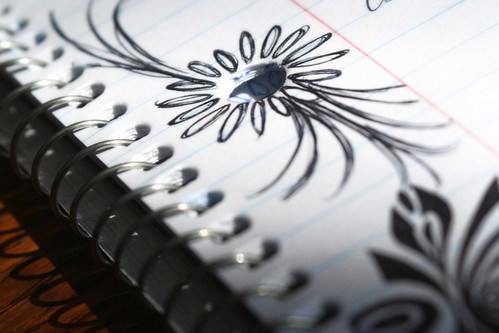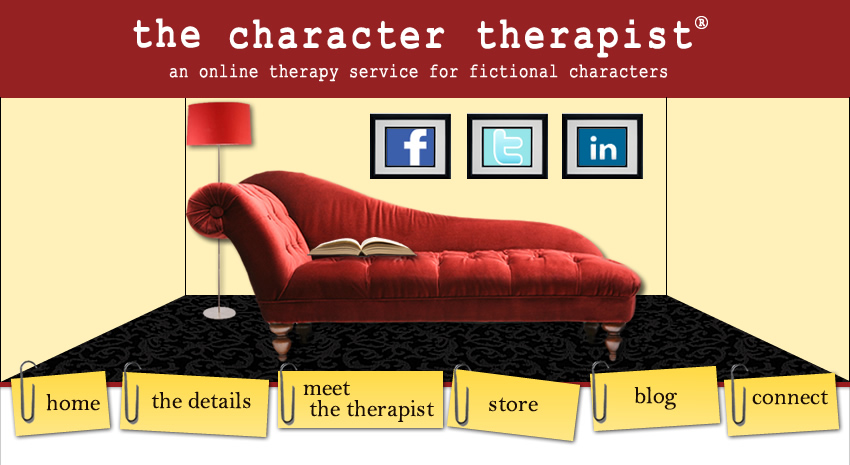 I'm about to surprise some of you about the type notes therapists take in session. Like most things I've already mentioned, notes differ according to the therapist.
I'm about to surprise some of you about the type notes therapists take in session. Like most things I've already mentioned, notes differ according to the therapist.There are online notes, handwritten notes, typed notes. Then there are diagrams (which really are sometimes the best way to communicate information succinctly, even in notetaking form), outlines, timelines, genograms (will discuss later) and the occasional doodle when bored. (Just kidding!)
I fall into the category of therapists who use an outline (of sorts) to take my notes. This happened because I started writing notes in a psychiatric hospital, and we had to follow a BIRP guideline for all notes. (And we seriously would ask, "Have you BIRPed yet?" before we could leave for the day. Not kidding on this one.)
B = Behavior
I = Intervention
R = Response
P = Plan
There are different variations of this type of guideline, used for different insurance purposes or personal preferences or company expectations.
Like MIRP:
M = Medical Necessity
I = Intervention
R = Response
P = Plan
And SOAP:
S = Subjective
O = Objective
A = Assessment
P = Plan
You can see some similarities between the three guidelines I've listed.
 BIRP notes were for in-patient clients whose behavior had to monitored closely. So every person on every shift had to write a BIRP note about that person's behavior, how the therapist/psych technician intervened in the behavior (modeling appropriate behavior, talking to them using a particular method, etc), the client's response and the overall plan for that client's continued therapy (how you're going to implement goals, address the problem behavior, etc).
BIRP notes were for in-patient clients whose behavior had to monitored closely. So every person on every shift had to write a BIRP note about that person's behavior, how the therapist/psych technician intervened in the behavior (modeling appropriate behavior, talking to them using a particular method, etc), the client's response and the overall plan for that client's continued therapy (how you're going to implement goals, address the problem behavior, etc).It's almost the exact same with MIRP. Medical necessity exists because of behaviors or thoughts or emotions that the client wants to change. So that's what the therapist would put under "medical necessity": behaviors, thoughts, emotions. Could be overly tearful, of self-berating thoughts, or lowered self-esteem (but you'd have to indicate how this was the case...see treatment plan post). I used MIRP notes when working for a private, non-profit. MIRP was good for insurance and auditing purposes...b/c it forces the clinician to stick to the treatment plan (which is first and foremost). In an audit, if you weren't sticking to the treatment plan, then they could "disallow" what you billed for that session, which would cost the company moolah (and that might just come out of your check if you're the culprit). Thankfully, I was never disallowed on any of my notes. :)
In private practice, however, I prefer SOAP notes. It keeps everything nice, tidy and clean (no pun intended). I usually start a session with a notepad already doctored with the S, O, A and P strategically lined along the left side of my page. What clients say or do would go under "subjective." It's their actual experience in therapy. A client might say, "I feel worthless." I'd jot this under my
 "S" on my notepad. What I actually observe goes under "O" for objective. This is my clinical expertise at work...the reading in between the lines of what's being said. I note discrepancies between what a client says and does. I scribble down reactions (like when a client easily breaks down...what prompted it?), pregnant silences (what question did I ask that prompted the client to close off or be reluctant to speak?), how many times I had to keep the client from chasing rabbits. Things like this. Under "Assessment," I might write down any clinical tool I used, or what my overall impression of the session was, including how I think the goals we've set are being met and what might be done additionally to assess where the client currently is. The "P" section is the same as under BIRP and MIRP.
"S" on my notepad. What I actually observe goes under "O" for objective. This is my clinical expertise at work...the reading in between the lines of what's being said. I note discrepancies between what a client says and does. I scribble down reactions (like when a client easily breaks down...what prompted it?), pregnant silences (what question did I ask that prompted the client to close off or be reluctant to speak?), how many times I had to keep the client from chasing rabbits. Things like this. Under "Assessment," I might write down any clinical tool I used, or what my overall impression of the session was, including how I think the goals we've set are being met and what might be done additionally to assess where the client currently is. The "P" section is the same as under BIRP and MIRP.This said, many therapist choose to write stream of consciousness during session...using key words, phrases or the like and then transposing them into a guideline system or just filing them as is in the client's file. Since I'm Type A, I like to type my notes up, and generally I'll include more information in the typed version. As for filing, I typically use a regular manila folder with brads at the top of both sides to secure my notes, intake papers, releases of information, treatment plans, etc. for each client. Some companies use the folders to the left, which hold much more information, include more inserts with brads to section off paperwork better.
So, there you have it. Therapy notes is much more than a nutshell, but hopefully it was informative.
Q4U: Think about doing a BIRP or SOAP note after each scene. Where are you going with your story? Does the character's behaviors/actions line up with this?
Don't forget...there's still time to sign up to win Mary DeMuth's new book, A Slow Burn, and it's prequel, Daisy Chain, if you leave your name in the comments section here.









11 comments:
Wow, you guys have to pay a lot of attention to your clients--got to be seriously draining for you!! The reaction part is what I wondered about. What happens if you interpret their reaction wrong, though? Does a therapist pick up on reading someone wrong fairly quickly, if they aren't your standard typical responsive types?
hmm. good question. i suppose there are times when you read a person wrong, but usually the visceral reaction (tears, shudders, grimaces, that type thing) aren't misread. but i'd have to take into consideration if a person typically frowns all the time, or something like that. of course, if i was wrong, i'd note it in my notes later.
this is exactly why I am a writer and not a therapist.all that note taking would send me off the deep end. Bu tI am glad that someone does it:) My own therapist never takes notes during our session. She never has. Why would that be? Do you think she writes me up afterwards??? Just curious. I could ask her myself I suppose.
I love the idea of doing BIRB or SOAP after we write scenes to keep our stories under control. :)
tabitha - my guess is that she writes you up afterward. at least, that's what i would do. some people are uncomfortable with the therapist taking notes during session, and i always like to take that into consideration. but i do know some private therapists who don't keep notes. this is amazing to me! (but i'm Type A, for sure. dot all my i's and cross all my t's.)
How enlightening! I went through counseling when I was going through my divorce and I always wondered what she was writing over there. Of course, we never get to see that!
What an intesting way to look at our scenes.
Thanks, Jeanie. By the way, that picture could be from my college notes as well. I'm a doodler.
I was a SOAP note girl! I just love reading your blog, reminds me of my time spent on the unit. (as a therapist, lol)
SOAP notes are my favorite, t.anne. i SOAP up after every client. :)
Very helpful! Thanks for the inside look.
Stephanie Faris said...
How enlightening! I went through counseling when I was going through my divorce and I always wondered what she was writing over there. Of course, we never get to see that!
Actually by law you have a right to see your file so if you are interested you should ask...
Post a Comment
Both comments and questions are welcome. I hope you enjoyed your time on the couch today.